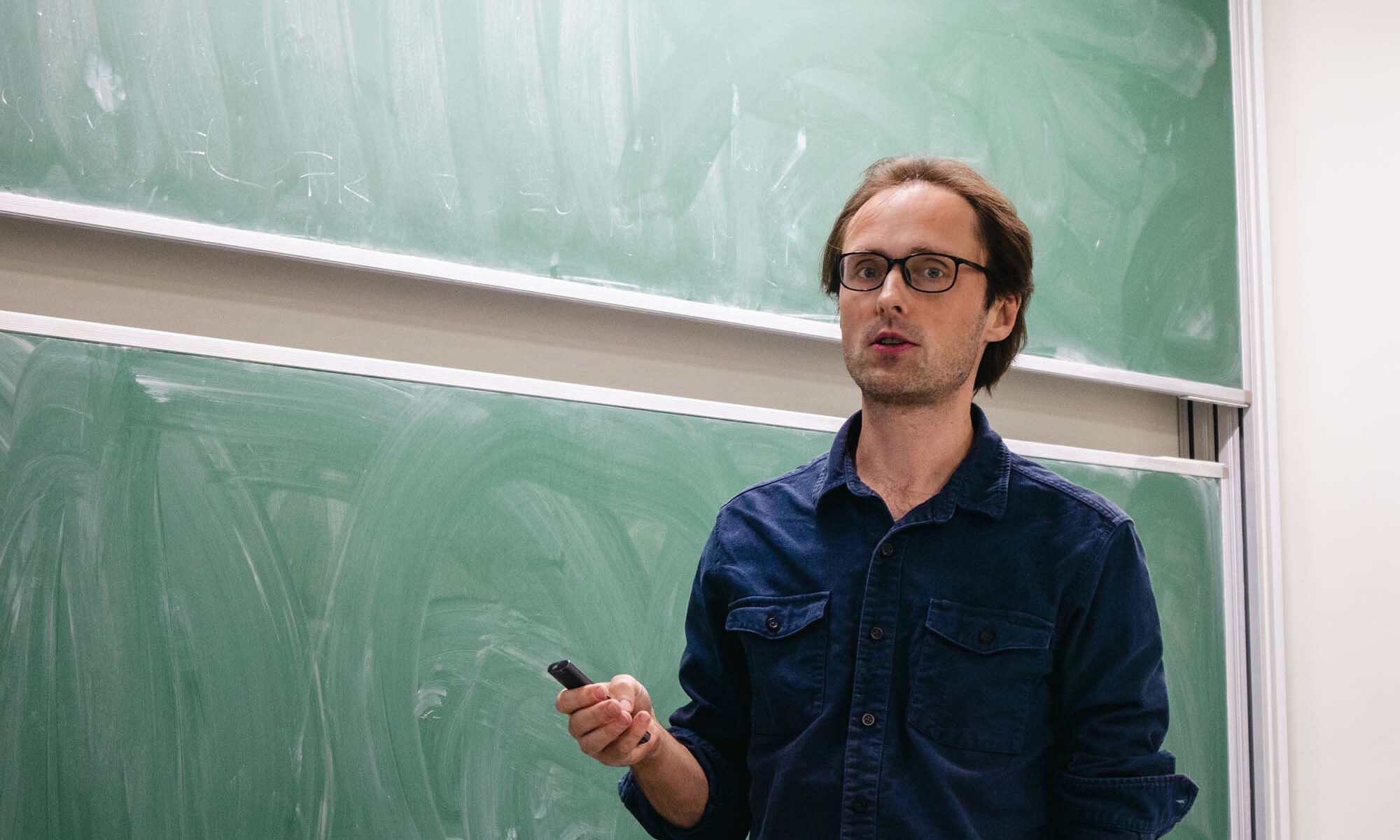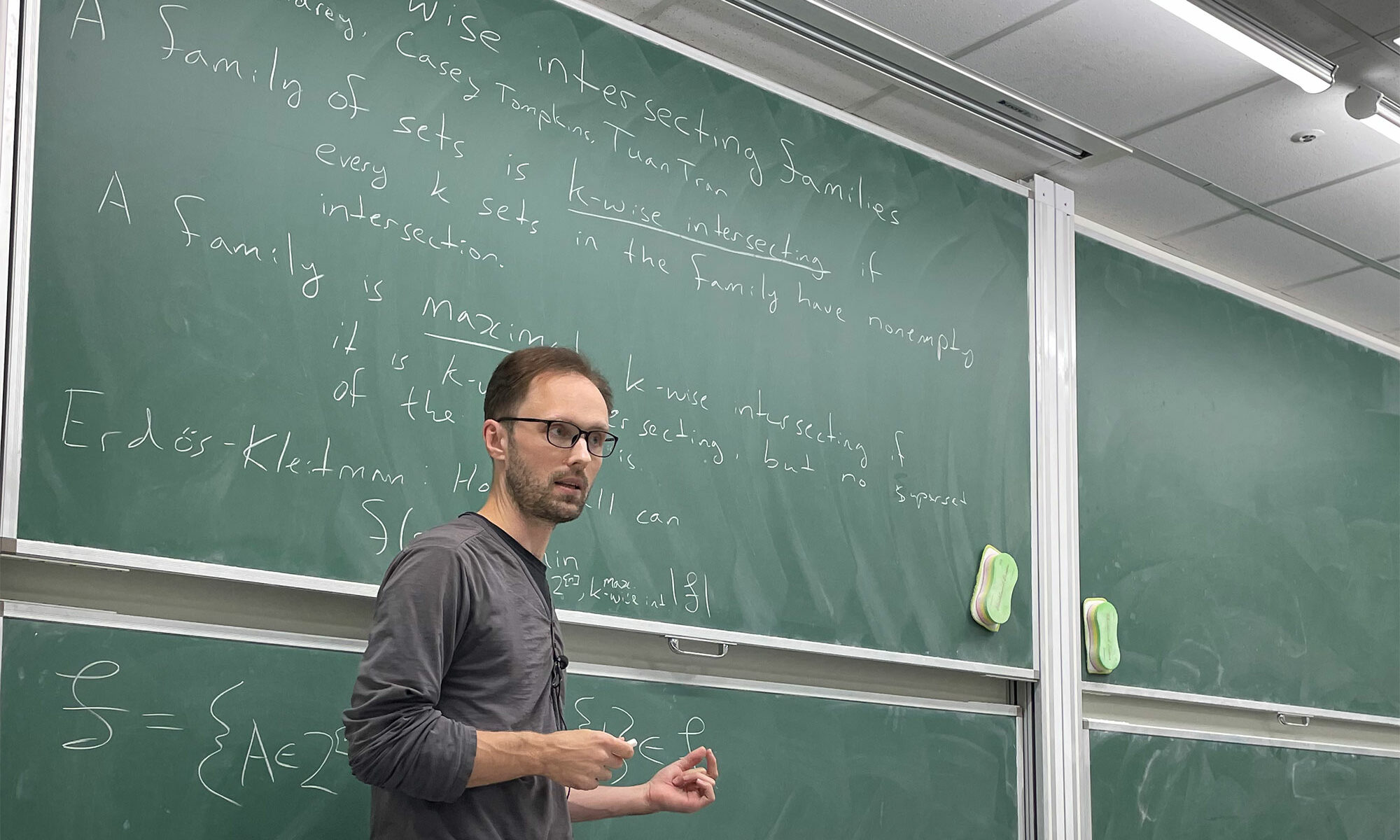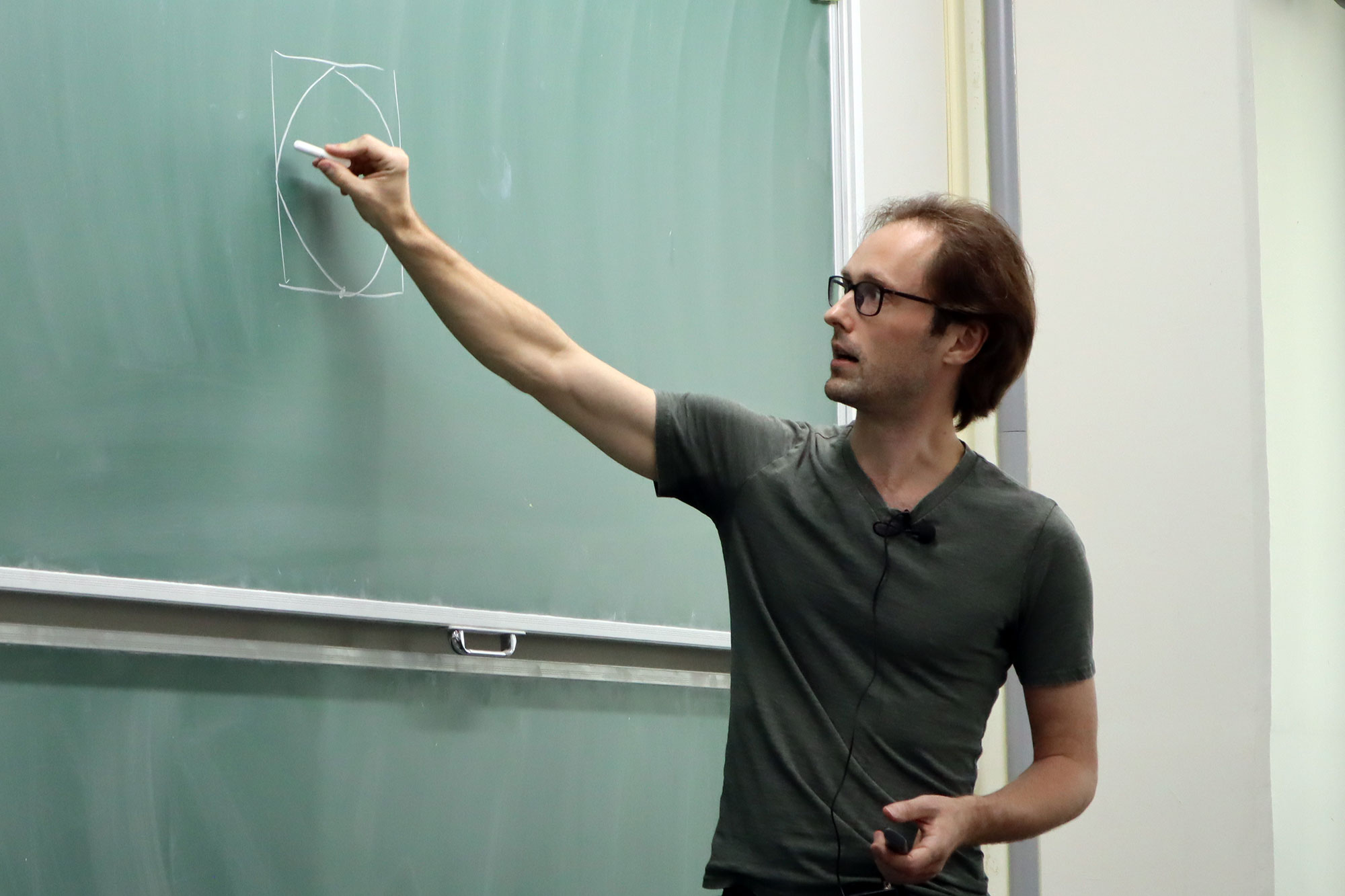On December 4, 2023, Ben Lund from the IBS Discrete Mathematics Group gave a talk at the Discrete Math Seminar on the existence of an embedding of every almost spanning tree with specified distances of edges into a finite vector space. The title of his talk was “Almost spanning distance trees in subsets of finite vector spaces.”
Ben Lund, Almost spanning distance trees in subsets of finite vector spaces
For $d\ge 2$ and an odd prime power $q$, let $\mathbb{F}_q^d$ be the $d$-dimensional vector space over the finite field $\mathbb{F}_q$. The distance between two points $(x_1,\ldots,x_d)$ and $(y_1,\ldots,y_d)$ is defined to be $\sum_{i=1}^d (x_i-y_i)^2$. An influential result of Iosevich and Rudnev is: if $E \subset \mathbb{F}_q^d$ is sufficiently large and $t \in \mathbb{F}_q$, then there are a pair of points $x,y \in E$ such that the distance between $x$ and $y$ is $t$. Subsequent works considered embedding graphs of distances, rather than a single distance. I will discuss joint work with Debsoumya Chakraborti, in which we show that every sufficiently large subset of $\mathbb{F}_q^d$ contains every nearly spanning tree of distances with bounded degree in each distance. The main novelty in this result is that the distance graphs we find are nearly as large as the set $S$ itself, but even for smaller distance trees our work leads to quantitative improvements to previously known bounds. A key ingredient in our proof is a new colorful generalization of a classical result of Haxell on finding nearly spanning bounded-degree trees in expander graphs. This is joint work with Debsoumya Chakraborti.
Ben Lund gave a talk on radial projections in a vector space over a finite field at the Discrete Math Seminar
On June 27, 2022, Ben Lund from the IBS Discrete Mathematics Group gave a talk at the Discrete Math Seminar on a large set of points with small radial projections in a vector space over a finite field. The title of his talk was “Radial projections in finite space“.
Ben Lund, Radial projections in finite space
Given a set $E$ and a point $y$ in a vector space over a finite field, the radial projection $\pi_y(E)$ of $E$ from $y$ is the set of lines that through $y$ and points of $E$. Clearly, $|\pi_y(E)|$ is at most the minimum of the number of lines through $y$ and $|E|$. I will discuss several results on the general question: For how many points $y$ can $|\pi_y(E)|$ be much smaller than this maximum?
This is motivated by an analogous question in fractal geometry. The Hausdorff dimension of a radial projection of a set $E$ in $n$ dimensional real space will typically be the minimum of $n-1$ and the Hausdorff dimension of $E$. Several recent papers by authors including Matilla, Orponen, Liu, Shmerikin, and Wang consider the question: How large can the set of points with small radial projections be? This body of work has several important applications, including recent progress on the Falconer distance conjecture.
This is joint with Thang Pham and Vu Thi Huong Thu.
Ben Lund gave a talk on the threshold function for a random subset of a finite vector space to have certain intersection properties with all m-dimensional affine subspaces at the Discrete Math Seminar
On March 28, 2022, Ben Lund from the IBS Discrete Mathematics Group gave a talk at the Discrete Math Seminar on the threshold function for a random subset of a finite vector space to have certain intersection properties with all m-dimensional affine subspaces at the Discrete Math Seminar. The title of his talk was “Thresholds for incidence properties in finite vector spaces“.
Ben Lund, Thresholds for incidence properties in finite vector spaces
Suppose that $E$ is a subset of $\mathbb{F}_q^n$, so that each point is contained in $E$ with probability $\theta$, independently of all other points. Then, what is the probability that there is an $m$-dimensional affine subspace that contains at least $\ell$ points of $E$? What is the probability that $E$ intersects all $m$-dimensional affine subspaces? We give Erdős-Renyi threshold functions for these properties, in some cases sharp thresholds. Our results improve previous work of Chen and Greenhill. This is joint work with Jeong Han Kim, Thang Pham, and Semin Yoo.
Ben Lund, Maximal 3-wise intersecting families
A family $\mathcal F$ of subsets of {1,2,…,n} is called maximal k-wise intersecting if every collection of at most k members from $\mathcal F$ has a common element, and moreover, no set can be added to $\mathcal F$ while preserving this property. In 1974, Erdős and Kleitman asked for the smallest possible size of a maximal k-wise intersecting family, for k≥3. We resolve this problem for k=3 and n even and sufficiently large.
This is joint work with Kevin Hendrey, Casey Tompkins, and Tuan Tran.
Ben Lund gave a talk on the smallest size of maximal 3-wise intersecting families of sets at the Discrete Math Seminar
On November 2, 2021, Ben Lund from IBS Discrete Mathematics Group gave a talk on the smallest possible size of a maximal 3-wise intersecting family of subsets of {1,2,…,n} for large n, answering a problem of Erdős and Kleitman proposed in 1974. The title of his talk was “Maximal 3-wise intersecting families“.
Ben Lund gave a talk on the existence of a limit shape for lattice zonotopes at the Discrete Math Seminar
On May 25, 2021, Ben Lund from the IBS Discrete Mathematics Group gave a talk at the Discrete Math Seminar on the existence of a limit shape for lattice zonotopes in all dimensions and other relevant results. The title of his talk was “Limit shape of lattice Zonotopes“.
Ben Lund, Limit shape of lattice Zonotopes
A convex lattice polytope is the convex hull of a set of integral points. Vershik conjectured the existence of a limit shape for random convex lattice polygons, and three proofs of this conjecture were given in the 1990s by Bárány, by Vershik, and by Sinai. To state this old result more precisely, there is a convex curve $L \subset [0,1]^2$ such that the following holds. Let $P$ be a convex lattice polygon chosen uniformly at random from the set of convex lattice polygons with vertices in $[0,N]^2$. Then, for $N$ sufficiently large, $(1/N)P$ will be arbitrarily close (in Hausdorff distance) to $L$ with high probability. It is an open question whether there exists a limit shape for three dimensional polyhedra.
I will discuss this problem and some relatives, as well as joint work with Bárány and Bureaux on the existence of a limit shape for lattice zonotopes in all dimensions.






